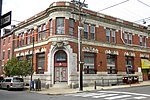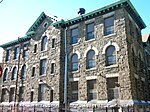Mary Channing Wister School

Mary Channing Wister School, originally the Mary Channing Wister Public School, is a historic school building located in the Poplar neighborhood of Philadelphia, Pennsylvania. It was designed by Irwin T. Catharine and built in 1925–1926. It is a three-story, three bay, brick building on a raised basement in the Art Deco-style. An addition was built in 1960. It features a freestanding portico with Doric order columns and decorative tile. It is named for the civic leader Mary Channing Wister, the wife of Owen Wister. It was added to the National Register of Historic Places in 1988.In 2001, the building was renovated to become a new forensic science laboratory for the Philadelphia Police Department. While the facade remains true to the original design with little change, the inside of the building was completely renovated and designated a Green building. The new laboratory is called the Forensic Science Center, operated by the Office of Forensic Science within the Philadelphia Police Department.
Excerpt from the Wikipedia article Mary Channing Wister School (License: CC BY-SA 3.0, Authors, Images).Mary Channing Wister School
North 8th Street, Philadelphia
Geographical coordinates (GPS) Address Nearby Places Show on map
Geographical coordinates (GPS)
| Latitude | Longitude |
|---|---|
| N 39.967 ° | E -75.1505 ° |
Address
Philadelphia Police Forensic Science Center
North 8th Street
19133 Philadelphia
Pennsylvania, United States
Open on Google Maps









